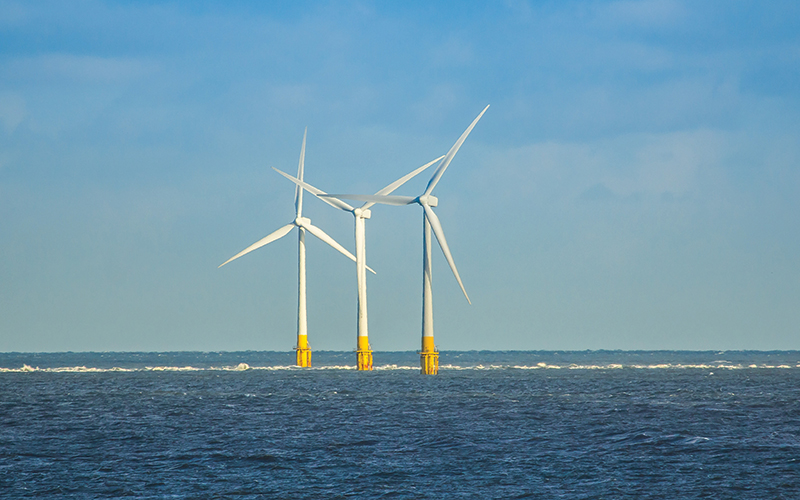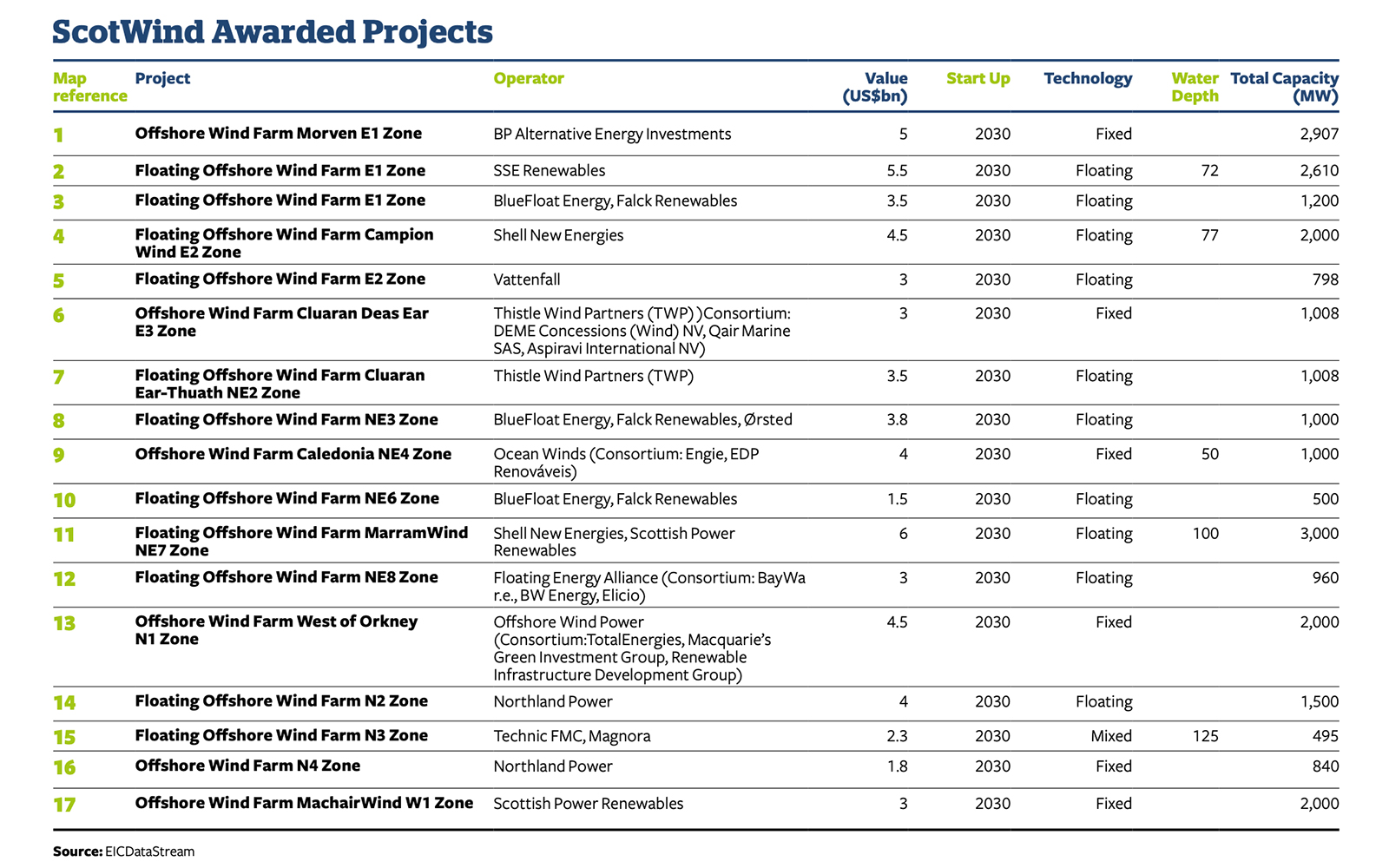Floating wind: A chance for offshore success
The ScotWind tender results mark the commercial breakthrough of floating offshore wind, but we need significant and sustained investment in infrastructure and supply chain capability if the UK is to deliver the technology at scale and cement itself as a world leader, says Professor Sir Jim McDonald FREng FRSE, President of the Royal Academy of Engineering

In one day, the recently announced ScotWind offshore wind leasing round added a pipeline equivalent to double that of all the UK offshore wind currently in operation. Of the 24.8GW of new capacity expected to be developed, 15GW will come from floating wind – enough for the annual power needs of around 10m homes. This demonstrates Scotland’s huge ambition to develop the global offshore wind market and indicates the scale of necessary action to achieve net zero.
Offshore wind is increasingly recognised as both a source of much-needed additional renewable capacity and a major economic opportunity for the UK, as outlined in the government’s net-zero strategy. Floating wind platforms, whereby wind turbines are tethered by mooring lines to the seabed, allow turbines to be located in deeper waters than fixed-bottom wind farms. This opens up vast areas of the deep sea for generating renewable power, where the strongest winds tend to form. Doing so is critical for the development of clean energy in not only the UK, but also other countries with access to deep waters, such as the US, South Korea, Japan, China, Norway, France and Spain.
The floating wind market is maturing. Other facilities, such as Gwynt Glas in the Celtic Sea, set to be the world’s largest floating wind farm, have been announced – but what we need now is rapid upscaling. The portfolio of projects anticipated to flow from ScotWind (see Figure 1) will provide an opportunity for the UK to lead on floating wind, and to show the world the role of engineering in achieving net zero.
Winds of change: opportunities for economic development and clean energy
Leveraging power from floating wind to transition to a low-carbon economy comes with many advantages. Not only can it generate more energy from stronger winds, but it can also reduce construction costs and delays by integrating turbines at sheltered locations before deployment. Additionally, developing the floating wind industry could significantly boost coastal economies.
UK offshore wind currently accounts for 13% of the UK’s total electricity generation

In Scotland, it would enable industry to build on its rich heritage in offshore systems, subsea engineering and manufacturing, echoing the beginnings of the domestic oil and gas sector. Floating wind provides a practical route for oil and gas workers to transfer their skills to renewable energy. Across the UK, floating wind has the potential to deliver £43.6bn in UK gross value add (GVA) by 2050, creating more than 29,000 jobs in the process, including many employment opportunities for engineers and technicians. By gaining an early-mover advantage, the UK is well placed to create a globally competitive supply chain, project delivery reputation and experienced talent pool, and to sell its specialised engineering expertise to other countries adopting floating wind energy.
The UN’s International Renewable Energy Agency forecasts that 90% of electricity will be generated by renewable sources by 2050. A huge global shift is required to achieve this. In the UK, offshore wind currently accounts for 13% of our total electricity generation. However, it will need to form a much higher proportion if we are to meet our commitment to 100% clean electricity by 2035.
Significant further investment in floating wind is needed for the UK to reach its clean energy potential.
Nearly 15GW of new floating wind capacity to be created from ScotWind – enough to power around 10m homes annually
Accelerating investment
Making commitments to upscale offshore wind is one thing – but delivering on that objective is another. So, for example, how can the ambitions of ScotWind be realised?
The first challenge is, unsurprisingly, cost – but this challenge has been overcome before. With fixed offshore wind, we have seen how swift upscaling, continued innovation and high-value engineering enable costs to fall; the significant reduction in £/MWh of offshore wind over the past decade shows that. Such an approach, in turn, precipitates further growth in global market development, UK jobs and exports.
A second challenge is the level of infrastructure needed. The immense size of floating offshore wind structures requires a great deal of space to accommodate their manufacture. ScotWind, for example, will require up to 500 hectares (ha) of space for marshalling and assembly facilities, but Scotland currently only has an estimated 50ha available in its six largest facilities. It is vital that more collaboration between ports should be encouraged to overcome barriers related to lack of space. Forming ‘port clusters’ borne out of the combined efforts of multiple ports could help to provide the additional capacity needed.
Additionally, the visibility of a long-term pipeline could help to create the cycle of investment needed for implementation. A healthy project pipeline inspires confidence and encourages investment in infrastructure and supply chain capability, and as upscaling occurs, costs may decrease, stimulating further investment and employment opportunities. This fosters a long-term approach and accelerates investment in research and innovation, which will become increasingly necessary if the UK is to cement its position as a global leader in offshore wind technology.
It is also important to take account of the floating wind turbine’s life cycle, including costs and responsibility for decommissioning. We must never forget the sustainability of the technologies themselves. And investment in creating sustainable end-of-cycle turbine designs to prevent environmental harm is also needed to further future-proof the enduring potential of floating wind.
Looking to the horizon
As the UK sets out to meet its net-zero ambitions following COP26 and its focus on ‘levelling up’, new floating wind facilities have the potential to reinvigorate our offshore energy success to date. However, to ensure that the UK delivers on this potential in the decades to come, we must continue to invest in infrastructure, skills, technology and innovation. ScotWind is just the beginning.

Image credit | Shutterstock






Follow us
Advertise
Free e-Newsletter